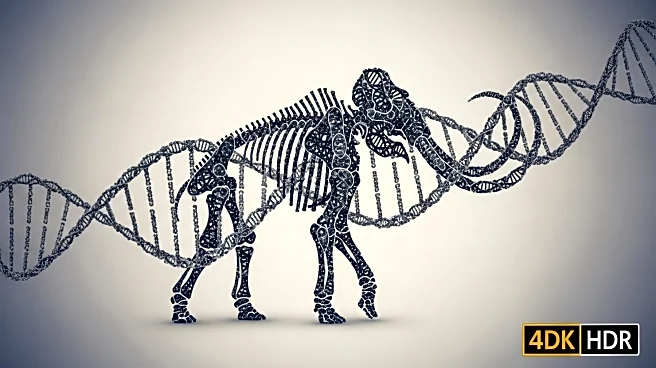What's Happening?
A recent study published in Science has uncovered a distinct mitochondrial lineage in mammoth DNA found in Mexico, challenging previous assumptions about the genetic similarity of these mammoths to the Columbian mammoth (Mammuthus columbi). The research, conducted during the construction of the Felipe Ángeles International Airport near Mexico City, involved analyzing mitochondrial DNA from mammoth fossils unearthed at the site. The study identified a unique lineage, referred to as Clade 1G, which is separate from other North American mammoth lineages. This discovery suggests a deeper genetic divergence within the Mexican mammoth population than previously thought. The researchers propose two potential explanations for this divergence: either a structured mitochondrial level in the ancestral population before hybridization or different parental populations admixing at various times. Radiocarbon dating indicates these lineages coexisted during the Late Pleistocene, between 40,000 and 12,700 years ago.
Why It's Important?
The findings of this study have significant implications for understanding the evolutionary history of mammoths in North America. By revealing a distinct genetic lineage in Mexican mammoths, the research challenges existing theories about the Columbian mammoth's origins and migration patterns. This could lead to a reevaluation of the species' evolutionary trajectory and its adaptation to different environments. The study also highlights the potential for recovering ancient DNA from tropical regions, which has traditionally been challenging due to the degradation of genetic material in warmer climates. This advancement could open new avenues for paleogenomic research, providing insights into the biodiversity and ecological dynamics of prehistoric species.
What's Next?
Future research may focus on further exploring the genetic diversity of mammoths across different regions in North America. Scientists might also investigate the environmental factors that contributed to the distinct genetic divergence observed in the Mexican mammoth population. Additionally, the study underscores the importance of expanding the geographical range of ancient DNA recovery efforts, which could lead to more comprehensive understandings of extinct species' evolutionary histories. Continued advancements in DNA extraction and analysis techniques will likely play a crucial role in these endeavors.
Beyond the Headlines
The study's findings raise intriguing questions about the impact of climate and geography on the genetic evolution of species. The ability to extract and analyze DNA from tropical latitudes could provide new perspectives on how ancient species adapted to diverse environmental conditions. This research also emphasizes the interconnectedness of ecosystems across time, as the genetic lineage of mammoths in Mexico may have been influenced by broader migratory and hybridization events across continents.











